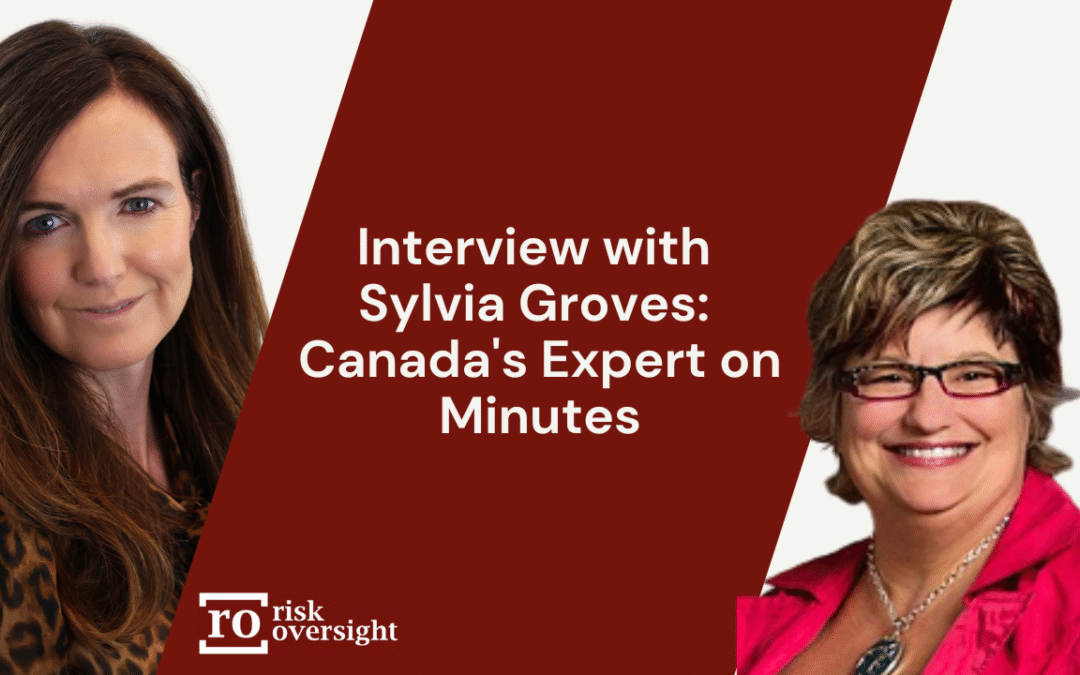An exclusive interview with Sylvia Groves, FCG, Acc.Dir., President of Governance Studio and the author of AAA+ Minutes.
In the world of corporate governance, few topics are as universally relevant yet misunderstood as meeting minutes. I recently had the privilege of sitting down with Sylvia Groves for a fascinating discussion about this critical aspect of board operations.
Sylvia is widely regarded as Canada’s foremost authority on minute best practices, having advised boards across industries and organization sizes throughout her distinguished career. Her book, AAA+ Minutes, has become an essential resource in a field where quality guidance has been noticeably lacking. For governance professionals, CPAs, auditors, and internal control specialists, Sylvia’s practical wisdom fills a significant gap in the professional literature.
Both Sylvia and I have collaborated with the Governance Professionals of Canada (GPC), an outstanding organization dedicated to elevating governance standards nationwide. Through this connection and our shared passion for effective board documentation, I was eager to explore questions that would provide valuable insights for our Risk Oversight community.
Q. What is the biggest misconception about minutes that directors and stakeholders should understand?
A. Most directors and other stakeholders don’t understand what minutes are designed to do. They’re not just rubber-stamping things. This is why you often see minutes that are either too long or too short.
Minutes need to be detailed enough to show the courts, your auditors, or your regulators that the board was having reasonable discussions with management. But you don’t want too much detail because, on the other side, excessive information is a litigator’s dream. They’ll work hard to take things out of context and say, “You asked these questions, but the obvious next question was this one, and nobody asked it, so we think you were being too lenient.”
Minutes are a board’s suit of armor. That is, their first and best defense in any litigation. Minutes are golden because they’re prima facie evidence. They don’t have to be proven true in court to be accepted; the judge automatically accepts them as 100% true unless someone can prove otherwise.
Directors often don’t realize how important minutes are for their protection. And this protection extends beyond just the directors – it protects the organization and the management team as well. Having strong, well-crafted minutes provides valuable evidence for litigation and demonstrates good practices to regulators and auditors.
Q. What are the common pitfalls in minute-taking?
A. The biggest issue I see with my clients is minutes being too long or detailed, which risks litigation and exposes individual directors. I often see long-winded discussions that are disorganized and hard to read. Minutes need to be concise yet comprehensive, and most importantly, easy to understand.
For smaller companies and startups, minutes that are too short are a common problem. These provide no context or proof that the board was doing its due diligence. They’re moving quickly and just noting, ‘We made this decision, that decision,’ with no supporting information.
Another huge issue is minutes that are not reader-friendly. Minutes should be easy to follow and not overwhelming. When there are 15 paragraphs, each running a page and a half long, directors won’t read them. Minutes shouldn’t look intimidating, like reading an insurance contract. This means we lose value because directors aren’t engaging with the content and may be overly trusting that management got everything right.
Naming individual directors is another big mistake. Minutes should frame discussions as the board as a whole, not individuals. Directors don’t make decisions; only boards make decisions. I always frame minutes as “the board discussed with management” or “the board challenged management’s assumptions about the growth rate for 2026.” It’s a group activity, not about who individually asked which question.
Q. How are lawyers and other professionals trained in minutes, and what are the shortcomings?
A. Most people learn minutes by copying what was done before them, not by studying best practices. We inherit historical practices without questioning them. Even corporate lawyers don’t get trained specifically in how to construct effective minutes.
I love the Institute of Corporate Directors (ICD), which does a wonderful job teaching directors about their substantive roles and responsibilities. But directors often receive no education whatsoever on what they should be paying attention to in minutes. They worry about typos, but they miss the bigger picture of what minutes should accomplish.
Q. In your book, you talk about having a consistent process to review minutes. Can you elaborate on that?
A. Having a consistent review process is key for better meeting minute practices. Documentation of the process is magical because then it’s not on me personally – it’s the process we’ve agreed to, and I’m just following it.
Most sets of minutes need to go through certain management members for feedback on their particular sections. For example, the Controller might review the section on board discussions of financial statements. I’m not a financial expert; the Controller is. I might word something in a way that casts a financial issue in a weird light that wasn’t quite right.
The challenge is when you send it to them for review, and it sits with them indefinitely while someone else starts getting on your case. You never want to throw anyone under the bus, so you’re trying to manage all of that. That’s why organizations should establish standards around their minute preparation process.
Some standards might include having minutes out to management for review within a specific timeframe – whatever that is. It depends on the organization. Some do this literally within two days, but those are typically organizations with monthly or six-week meeting cadences, which isn’t that common. Most will distribute minutes for review, maybe five business days after the meeting. Reviewers typically have only a day or two to review since they’re only responsible for a small piece. Then it goes to the CEO, and finally to the Chair.
The old practice, which is still common, is that the rest of the board or committee doesn’t see the minutes until the next meeting. If I can’t remember details after a few weeks, what do you think it’s like for them almost three months later? Are they going to remember and be able to provide any valuable feedback?
Q. I would never turn around my notes from a meeting 3 months later. And yet, it’s standard that boards review minutes at the next meeting. Why do we allow that?
A. It’s historical – that’s all I can say. It’s been a board practice for decades.
But ideally, the sooner you can turn them around, the better. I encourage organizations to distribute minutes faster, maybe within two or three weeks. As soon as the Chair has signed off and everybody’s comments have been incorporated, it really ought to go out to the Committee or Board. That way, if there are comments, those can be addressed and recirculated before the next meeting for approval
Q. I hate to ask you “the AI question” (which I’m sure you are getting a lot of nowadays). What about AI for minute-taking?
A. The AI debate goes back to the fundamentals of what minutes are about. They are not a transcript, they are a recap. Minutes are about professionalism, human synthesis, and sound judgment. It’s a failure of due diligence to think a machine will determine what should or shouldn’t be recorded.
I have several concerns with AI. First, unless you have your own enterprise AI system, that information is being recorded and sent elsewhere, and you have absolutely no control over it. It may or may not be secure. These are the most sensitive discussions an organization ever has – completely proprietary, strategic information. If you’re using public tools like Otter or ChatGPT without enterprise agreements in place, you’re releasing that information without any ability to control it.
Also, that information then becomes part of an organization’s large language model. It becomes part of what they use with other people. These broad AI systems are simply telling us the most common way someone would write notes about a particular discussion. That doesn’t mean they’re taking into account that this is a board meeting where directors need to demonstrate they’ve been duly diligent.
So there are concerns about information security, the proprietary nature of the information, and the fact that AI may not understand the legal and governance requirements of proper minute-taking.
Q. On a similar note, what are your thoughts on recording Board and Committee meetings?
A. Some organizations are actually required to record their public meetings like city councils or school boards where meetings must be made public through transcripts or recordings. That’s a totally different case; they’re following legal requirements.
But many people say, “I just want to record the meeting so I can listen to it again and create better minutes.” This approach is problematic because you’re essentially listening to the board meeting twice, and chances are you’re going to add a bunch more unnecessary detail. You might think, “I’ve heard this point multiple times, so it must be important,” which leads to longer minutes and takes more time.
What directors often don’t realize is that recordings, along with drafts and notes, need to be destroyed after the Board Chair has approved the final minutes. All these materials are discoverable in litigation. They provide fodder for a litigator to go through, and they will absolutely pull out irrelevant things and cast them in a bad light. Destroying them protects everyone – your fellow directors, yourself, and your management team.
As a governance professional, you want to protect your board. Once the minutes are finalized, you want one full, true, and final set of minutes that everybody has agreed covers the key items of the meeting. Many people get annoyed when told they should dispose of their documents, so with one organization I worked with, we actually had outside counsel provide a formal opinion because we knew the board wouldn’t listen to internal advice about getting rid of these materials.
***************
Thank you, Sylvia. This conversation has been absolutely fascinating. The insights you’ve shared today are exactly what our Risk Oversight community needs to hear, especially as governance responsibilities continue to expand in both scope and importance in today’s corporate landscape.
For our readers who want to learn more about Sylvia’s exceptional work, I encourage you to visit her website at Governance Studio or connect with her on LinkedIn.
Don’t miss downloading her free resource, “10 Secrets Directors Must Know about Minutes” from her website – it’s packed with essential insights for directors, auditors, internal control specialists, and governance professionals alike.
Sylvia’s book, “AAA+ Minutes,” is also available through her website and should be required reading for anyone responsible for governance documentation.
As governance standards continue to evolve, having a trusted expert like Sylvia to guide us through these essential practices reminds us that excellence in governance is built on attention to details that truly matter.

